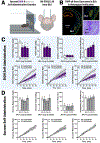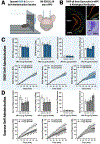Negative modulation of AMPA receptors bound to transmembrane AMPA receptor regulatory protein γ-8 blunts the positive reinforcing properties of alcohol and sucrose in a brain region-dependent manner in male mice
- PMID: 37055596
- PMCID: PMC10698495
- DOI: 10.1007/s00213-023-06365-z
Negative modulation of AMPA receptors bound to transmembrane AMPA receptor regulatory protein γ-8 blunts the positive reinforcing properties of alcohol and sucrose in a brain region-dependent manner in male mice
Abstract
Rationale: The development and progression of alcohol use disorder (AUD) are widely viewed as maladaptive neuroplasticity. The transmembrane alpha-amino-3-hydroxy-5-methyl-4-isoxazole propionic acid receptor (AMPAR) regulatory protein γ8 (TARP γ-8) is a molecular mechanism of neuroplasticity that has not been evaluated in AUD or other addictions.
Objective: To address this gap in knowledge, we evaluated the mechanistic role of TARP γ-8 bound AMPAR activity in the basolateral amygdala (BLA) and ventral hippocampus (vHPC) in the positive reinforcing effects of alcohol, which drive repetitive alcohol use throughout the course of AUD, in male C57BL/6 J mice. These brain regions were selected because they exhibit high levels of TARP γ-8 expression and send glutamate projections to the nucleus accumbens (NAc), which is a key nucleus in the brain reward pathway.
Methods and results: Site-specific pharmacological inhibition of AMPARs bound to TARP γ-8 in the BLA via bilateral infusion of the selective negative modulator JNJ-55511118 (0-2 µg/µl/side) significantly decreased operant alcohol self-administration with no effect on sucrose self-administration in behavior-matched controls. Temporal analysis showed that reductions in alcohol-reinforced response rate occurred > 25 min after the onset of responding, consistent with a blunting of the positive reinforcing effects of alcohol in the absence of nonspecific behavioral effects. In contrast, inhibition of TARP γ-8 bound AMPARs in the vHPC selectively decreased sucrose self-administration with no effect on alcohol.
Conclusions: This study reveals a novel brain region-specific role of TARP γ-8 bound AMPARs as a molecular mechanism of the positive reinforcing effects of alcohol and non-drug rewards.
Keywords: AMPA receptor; Alcohol use; Basolateral amygdala; JNJ-55511118; TARP γ-8.
© 2023. The Author(s), under exclusive licence to Springer-Verlag GmbH Germany, part of Springer Nature.
Figures




Similar articles
-
Transmembrane AMPA receptor regulatory protein TARP ɣ-8 is a target of ethanol that regulates self-administration and relapse in mice.Psychopharmacology (Berl). 2025 Jul 18. doi: 10.1007/s00213-025-06848-1. Online ahead of print. Psychopharmacology (Berl). 2025. PMID: 40679606
-
TARP ɣ-8 is a target of ethanol that regulates self-administration and relapse in mice.bioRxiv [Preprint]. 2025 Apr 1:2025.03.27.645788. doi: 10.1101/2025.03.27.645788. bioRxiv. 2025. Update in: Psychopharmacology (Berl). 2025 Jul 18. doi: 10.1007/s00213-025-06848-1. PMID: 40236160 Free PMC article. Updated. Preprint.
-
Inhibition of AMPA receptors (AMPARs) containing transmembrane AMPAR regulatory protein γ-8 with JNJ-55511118 shows preclinical efficacy in reducing chronic repetitive alcohol self-administration.Alcohol Clin Exp Res. 2021 Jul;45(7):1424-1435. doi: 10.1111/acer.14639. Epub 2021 Jun 22. Alcohol Clin Exp Res. 2021. PMID: 34086361 Free PMC article.
-
Preclinical and clinical sex differences in the effects of alcohol on measures of brain dopamine: a systematic review.Biol Sex Differ. 2025 Apr 8;16(1):24. doi: 10.1186/s13293-025-00706-7. Biol Sex Differ. 2025. PMID: 40200334 Free PMC article.
-
The Black Book of Psychotropic Dosing and Monitoring.Psychopharmacol Bull. 2024 Jul 8;54(3):8-59. Psychopharmacol Bull. 2024. PMID: 38993656 Free PMC article. Review.
Cited by
-
Distinct sex differences in ethanol consumption and operant self-administration in C57BL/6J mice with uniform regulation by glutamate AMPAR activity.Front Behav Neurosci. 2025 Jan 22;18:1498201. doi: 10.3389/fnbeh.2024.1498201. eCollection 2024. Front Behav Neurosci. 2025. PMID: 39911242 Free PMC article.
-
Ethanol self-administration targets GluA2-containing AMPA receptor expression and synaptic activity in the nucleus accumbens in a manner that drives the positive reinforcing properties of the drug.Psychopharmacology (Berl). 2025 Jun;242(6):1437-1452. doi: 10.1007/s00213-024-06740-4. Epub 2024 Dec 23. Psychopharmacology (Berl). 2025. PMID: 39714485 Free PMC article.
-
Transmembrane AMPA receptor regulatory protein TARP ɣ-8 is a target of ethanol that regulates self-administration and relapse in mice.Psychopharmacology (Berl). 2025 Jul 18. doi: 10.1007/s00213-025-06848-1. Online ahead of print. Psychopharmacology (Berl). 2025. PMID: 40679606
References
MeSH terms
Substances
Grants and funding
LinkOut - more resources
Full Text Sources
Medical
Miscellaneous

